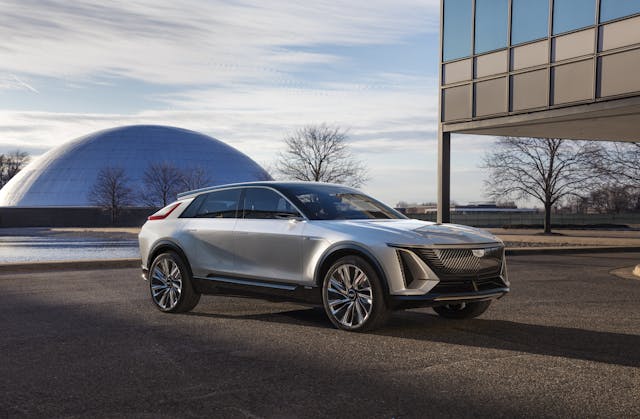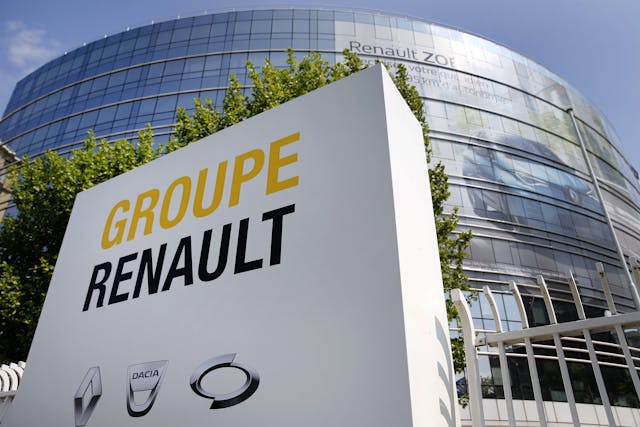MA will enforce Right to Repair, Jaguar Land Rover redefined, Hyundai and Kia struggle with anti-theft fix
Beginning Monday, The Manifold will be taking a brief hiatus. Still want to make sure you get the day’s news? Bookmark our homepage, and subscribe to our newsletter, baked fresh every morning with everything you need to know.
Massachusetts Attorney General begins enforcing embattled right-to-repair law
Intake: According to a new report from the Boston Globe, Massachusetts Attorney General Andrea Joy Campbell has been cleared by a federal judge to begin enforcing the state’s right-to-repair law, effective yesterday. The embattled law mandates that automakers provide consumers and independent repair shops with wireless access to a car’s telematic data to diagnose the vehicle’s performance so that independent shops can better repair ailing cars. Automakers say that the law puts their data security at risk and argue that the law is poorly drafted and hard to obey. The law was overwhelmingly supported by voters in a 2020 referendum, but automakers last Thursday asked U.S. District Judge Douglas Woodlock for a temporary restraining order to stop Cambell from enforcing the law. Woodlock criticized the law in an online hearing but said that because the law had such strong support, he would not grant the restraining order—thereby paving the way for Campbell to enforce it. “The people have voted on this and that’s the result,” said Woodlock. “I am loath to impose my own views on the initiative.”
Exhaust: Woodlock said that carmakers could still seek a preliminary injunction against the law, which is a more complex and time-consuming process, but in the meantime, automakers will be forced to share telematics data with independent shops in Massachusetts. Right-to-repair laws are a hot topic right now as cars get increasingly computer-controlled. In February, the House of Representatives introduced new legislation that aims to support the idea at a federal level. As of this writing, that legislation is still in the introductory stage. Let’s hope it moves through quickly. — Nathan Petroelje
JLR claims new branding brings clarity to customers

Intake: Jaguar Land Rover is now simply JLR. It’s also a “House of Brands” made up of Range Rover, Defender, Discover, and Jaguar but Land Rover fans needn’t fear, as the 75-year-old name will not be disappearing. “The Land Rover brand will remain a key part of the company’s DNA. Land Rover continues as a world-renowned and important heritage mark, remaining on vehicles, websites, social media, and retail sites, underpinning the world-class Range Rover, Defender, and Discovery brands,” confirms a JLR statement.
Exhaust: “This is the next chapter of our Reimagine journey to become a truly modern luxury business,” adds Chief Creative Officer Professor Gerry McGovern. “The new JLR identity will bring clarity to our clients and act as a unifier for our four distinct British brands.” All clear then? Didn’t think so. — Nik Berg
Columnist George Will no fan of EV goals

Intake: In a column in the Washington Post and other newspapers titled “Two-thirds of new cars will be EVs in nine years? That will not happen,” syndicated columnist George Will says, “[President] Biden wants EVs, which were only 5.8 percent of U.S. new car sales in 2022, to be 67 percent by 2032. (His initial target had been 50 percent by 2030.) So, consumer sovereignty must be extinguished. Congress would not risk the aggressive paternalism of mandating that Americans buy EVs. For progressives, however, Congress is to the body politic as the appendix is to the human body: unnecessary and troublesome.” Will says that without massive subsidies, EVs won’t meet Biden’s predictions.
Exhaust: “What is delicately called consumer hesitancy regarding EVs includes worries about charging them,” Will writes. “When U.S. automobile ownership surged from 8 million in 1920 to 20 million in 1929, drivers found gasoline because the private sector nimbly supplied service stations to meet demand. A century later, because industrial policy expects supply to precede demand, the Biden administration plans to spend $7.5 billion providing 500,000 charging stations for subsidized EV purchasers.” — Steven Cole Smith
Renault could face criminal prosecution over faulty engines

Intake: Renault could face criminal prosecution in France over faulty engines as a group of customers plans to lodge a complaint against the carmaker next week, the group’s lawyer told Reuters today. “We are going to file a complaint on Monday on behalf of at least several dozen people,” Christophe Leguevaques said, adding many other owners of Renault vehicles, as well as those of its Dacia brand and partner Nissan, could join the move. The complaint, first reported by Le Parisien newspaper, will be filed in criminal court, with claims ranging from “aggravated deceit, questionable business practices” to “fraud” and “endangering the life of others,” the lawyer said.
Exhaust: A Renault spokesperson said the company had been providing technical support and financial help to affected customers. “The Renault Group never stopped and continues reviewing demands that it is receiving,” the spokesperson said. And a spokesperson for Nissan, which produces some models with Renault, said it was “supporting any customers that may experience engine noise, misfiring, low power, or over-consumption of oil under our warranty and customer support policies.” The customers claim the carmakers should have issued a recall when they discovered problems with the 1.2-liter engine used in 400,000 vehicles in Europe between 2012 and 2016. — SCS
Rivian may lose Nasdaq Index spot

Intake: Shares of Rivian may get pushed out of the Nasdaq 100 Index as early as this month after falling more than 90 percent from their record high, according to JP Morgan Securities, as relayed by Bloomberg. The index typically removes the smallest members of the Nasdaq 100 if the company is weighted at less than 0.1 percent of the gauge for two consecutive months, JP Morgan analyst Min Moon wrote in a note on Thursday. Because Rivian was below 0.1 percent as of April 28 and May 31, Moon expects the carmaker to be excluded from the index on the third Friday of June. ON Semiconductor is ranked at the top of the eligible companies to replace the EV maker, Moon said.
Exhaust: Removal from the index would deal another blow to a stock that’s been beaten down since its November 2021 IPO. “After briefly riding the frenzy for all things related to EVs, Rivian’s shares started unraveling,” Bloomberg said. Investors soured on risky growth companies, correctly anticipating the Federal Reserve would raise rates to arrest inflation, in turn slowing the economy and making sales of an expensive electric pickup truck less likely. Representatives of Rivian and Nasdaq declined to comment on Thursday. —SCS
Hyundai and Kia having problems with anti-theft software

Intake: Software patches that Kia and Hyundai are distributing to help stop a nationwide crime fad in hot-wiring their older vehicles have issues, the companies said. Both marques have notified dealers that the software solutions “are not working perfectly,” said Automotive News. A service bulletin sent from Kia to dealers in February identified a compatibility issue involving vehicles equipped with remote start accessories. Another bulletin, issued last week, said the problem has not been remedied. A Hyundai service bulletin sent in April also advises that vehicles with aftermarket or add-on alarms or remote start systems may not operate normally if the software patch is installed.
Exhaust: The upgrades are part of a campaign the companies launched in February to protect 7 million Hyundai and Kia vehicles from the 2011 through 2022 model years that are particularly vulnerable to hot-wire theft. Thieves can quickly break into the vehicles, pop open their steering wheel columns and start the car with a USB plug or a similarly shaped tool. A video demonstrating how to start the vehicles surfaced on TikTok last year and set off a nationwide crime spree. — SCS
***
Check out the Hagerty Media homepage so you don’t miss a single story, or better yet, bookmark it. To get our best stories delivered right to your inbox, subscribe to our newsletters.



It’s hard to have any excitement for JLR (Just Losing, Really?) and their vehicles. Jag would have been my favorite but they are dead now to me.
The new JLR branding scheme brings “clarity to our clients” about as well as the company brings quality and reliability to their clients.
It’s about time there was legislation to force Manufacterers to share service knowledge with Independents.
Any other orientation is simply Greed.
George Will is right. Electric cars will be fully matured in about 2550.
JLR is dumb… but it has us reading and talking about it.
3-10 years from now they revert to Land Rover (that happens to sell Jaguars) and the news cycle continues.
Branding in automotive is in an interesting state… Stellantis anyone? (Sounds like a disease).
I know I’m biased but I can’t believe the brand loss being lamented here is Land Rover.
The right to repair law is only a step in the right direction. Most people do not know that if you own a car made 15 years ago and you lose one of the main computer processors, for most brands no replacement parts exist. There is an entire salvage industry growing around used electronics modules. If ityour vehicle is a rarer performance, car the situation can be dire as no used modules arecavailable. I experienced this myself on a 2004 sports car. Yet, car manufacturers refuse to release the firmware and associated specifications for their discontinued electronics so a third party can build a replacement with more modern silicon. In other words, car makers are saying, we won’t supply it and you can’t make it. So if your 15 year old car has only 5K miles on it, too bad. Buy a new one.
Over time, there will be few classics that are original made after the late 99’s as all silicon electronics will ultimately fail.
Agreed — a scary thought. As a former firefighter, I am a big fan of airbags, but I am leery of buying an older performance or sports car (say, 1997 thru 2007 or so) that would have airbags as a hobby car due to this concern: what happens when the ECU goes? And it applies to many hard parts too. Try finding an air intake duct for a Nissan Axxess (sold only briefly in the US, but for a string of years here in Canada and elsewhere) — NLA. A junkyard is your only hope. If you can’t find a used one or kludge a repair, the whole car is inop. And of course, the aftermarket will not supply that part because the sales volume would be too low. There ought to be a right to repair regarding hard parts as well: manufacturers would have to supply specs to allow replication, 3D printing, etc. I guess I’ll stick to pre-ECU cars with carbs for my projects. More fun wrenching on them anyway.
I may be the only person who can see both sides of the so-called right to repair law (deceptively called that specifically to mislead and whip up the public) but does no one else have a problem with voters demanding companies assist their competition, at their own expense? No one likes paying dealer service charges but product reliability should be a primary criteria for any company’s success.
Most people don’t fully understand why the big car makers are jumping so whole heartedly on the EV bandwagon. I think the biggest reason is that it’s simply easier to build an EV. The framework holding the parts together differs some, but you can have a motor and suspension then vary everything between. The same basic chassis can be used to put any shape body on it, and only a little structural work to change the size or carrying capacity. Kind of like the original VW Bug floor pan – it was lengthened to create the bus, and many bodies were placed on it, even an off-road “Jeep” (Kubelwagen and “Thing”). With an EV this process is even easier — no mechanical linkages between the front and back, just wires. From a manufacturing from scratch point of view it’s a whole lot more economical to build an EV than a ICE vehicle. Now that the battery technology is basically there the big hindrance (range and recharge time) is gone for 80% of drivers. Still not goo for long range trips, but most of us can easily deal with a 200-300 mile range for 80% of our driving. I could in my handyman business. I drive an average of 80 miles a day. If I had an electric pickup with a 250-300 mile rated range I’d be fine, even on the few days I use a trailer to carry outsized items or haul away debris. I mainly do smaller jobs, so don’t use a trailer more than 10-12 times a year. Even if hauling cuts the range in half I’d still have plenty capacity to do the job though. And I don’t haul really heavy loads, so range shouldn’t be cut quite in half.